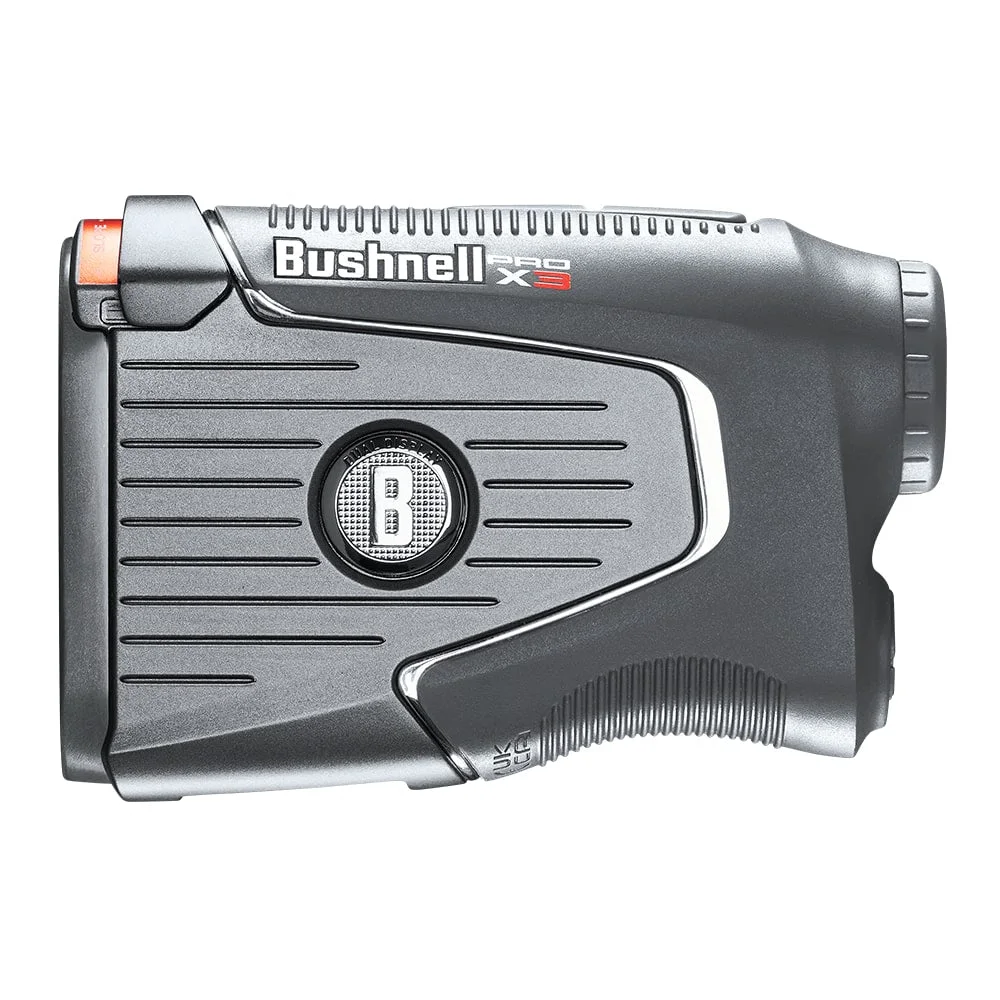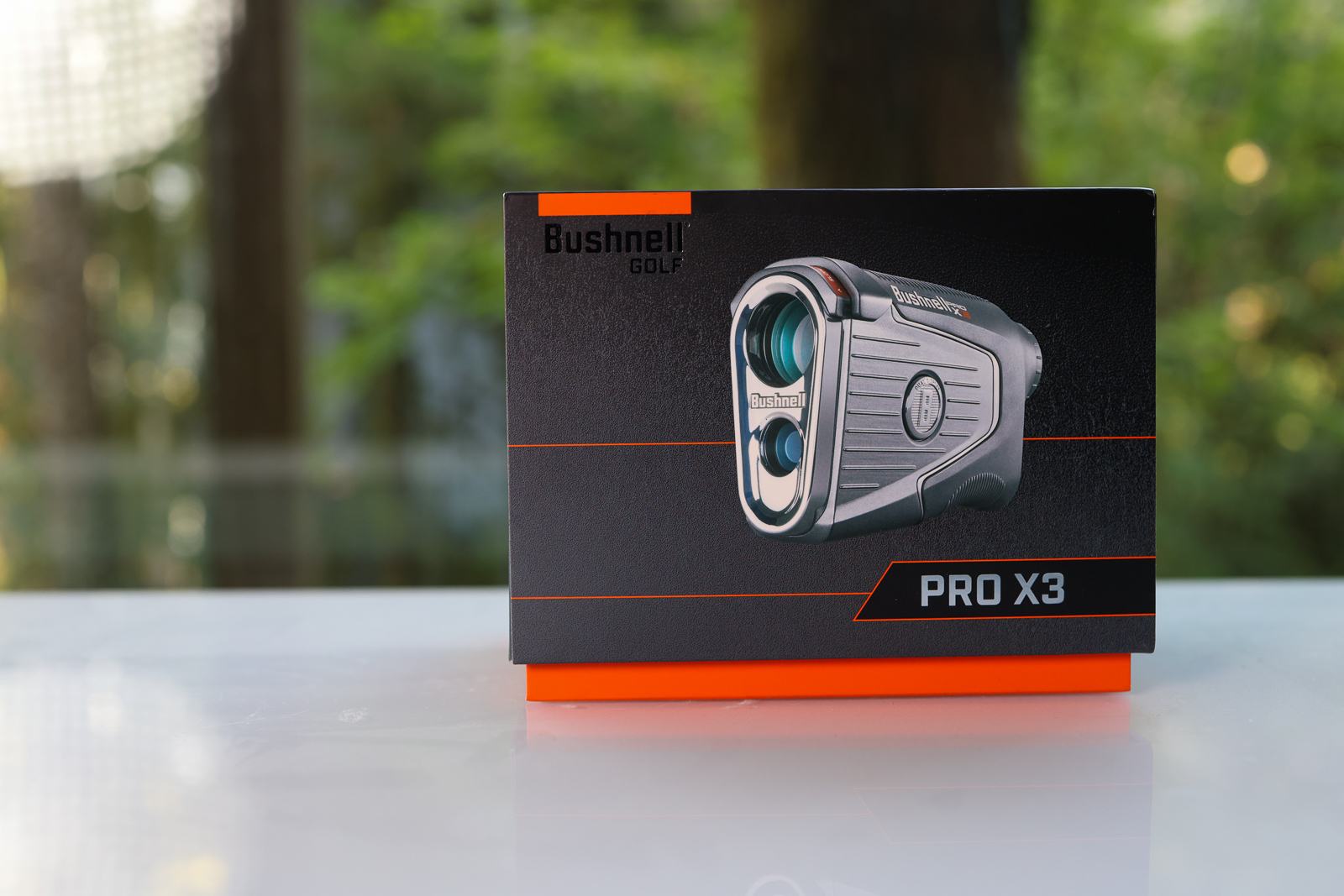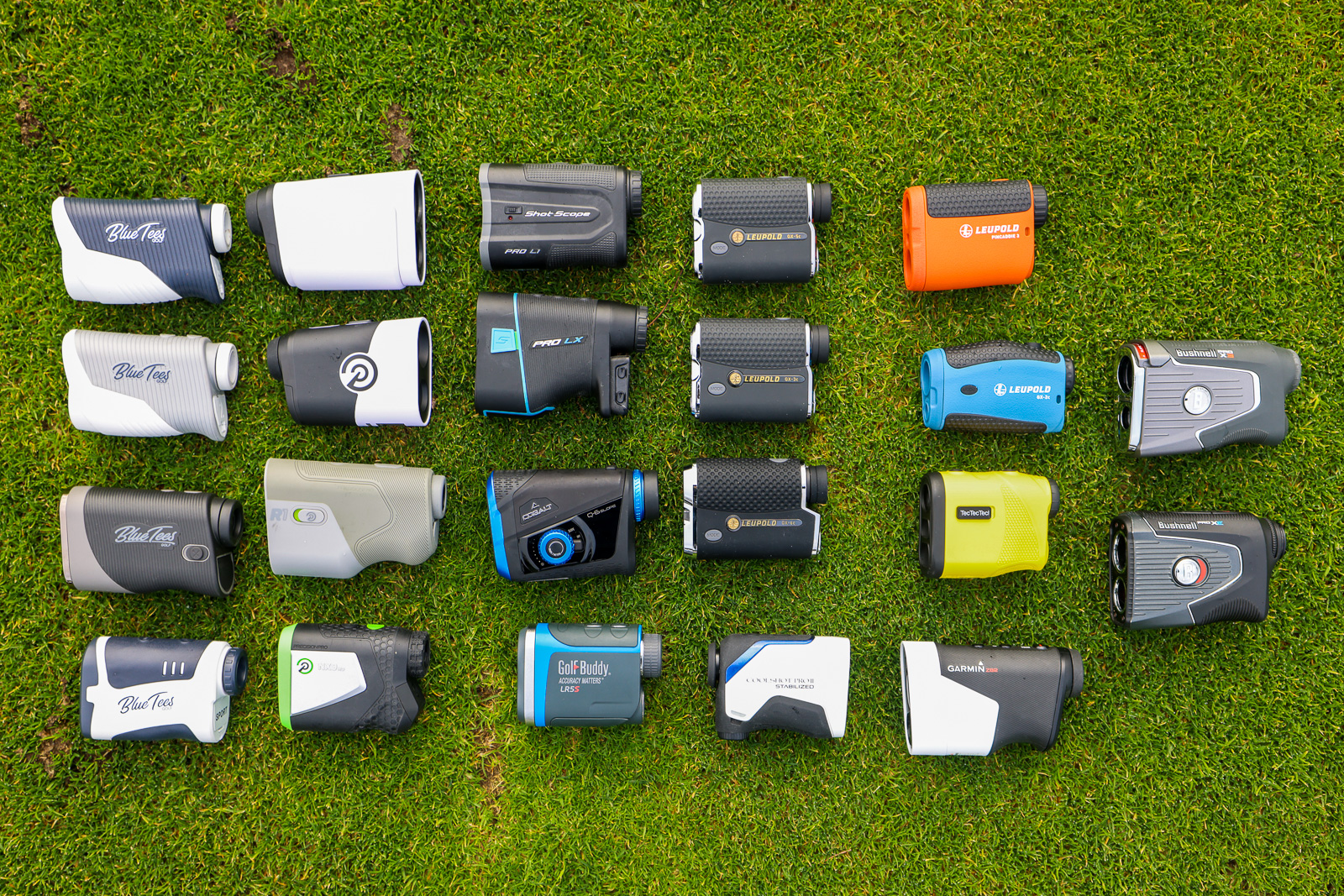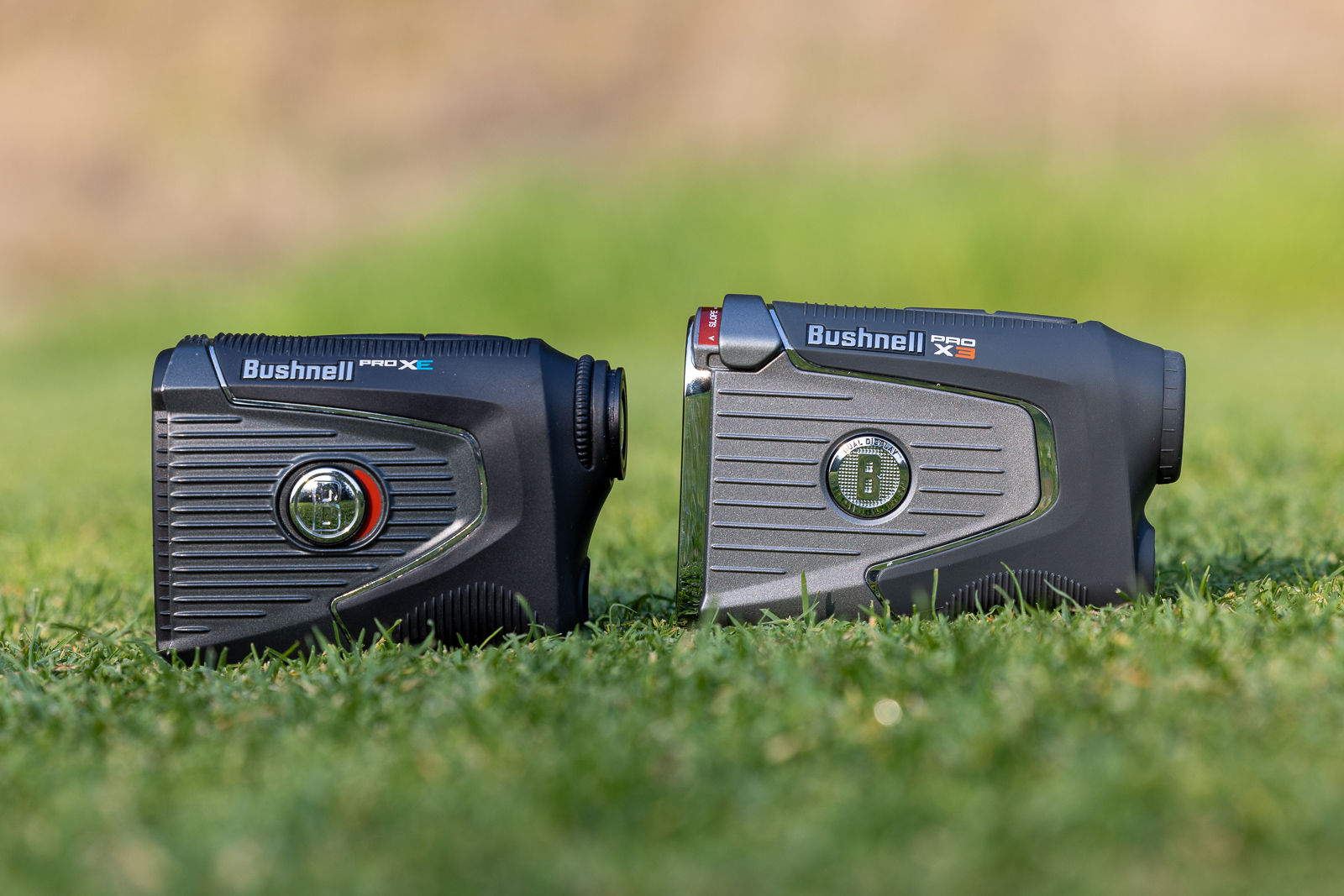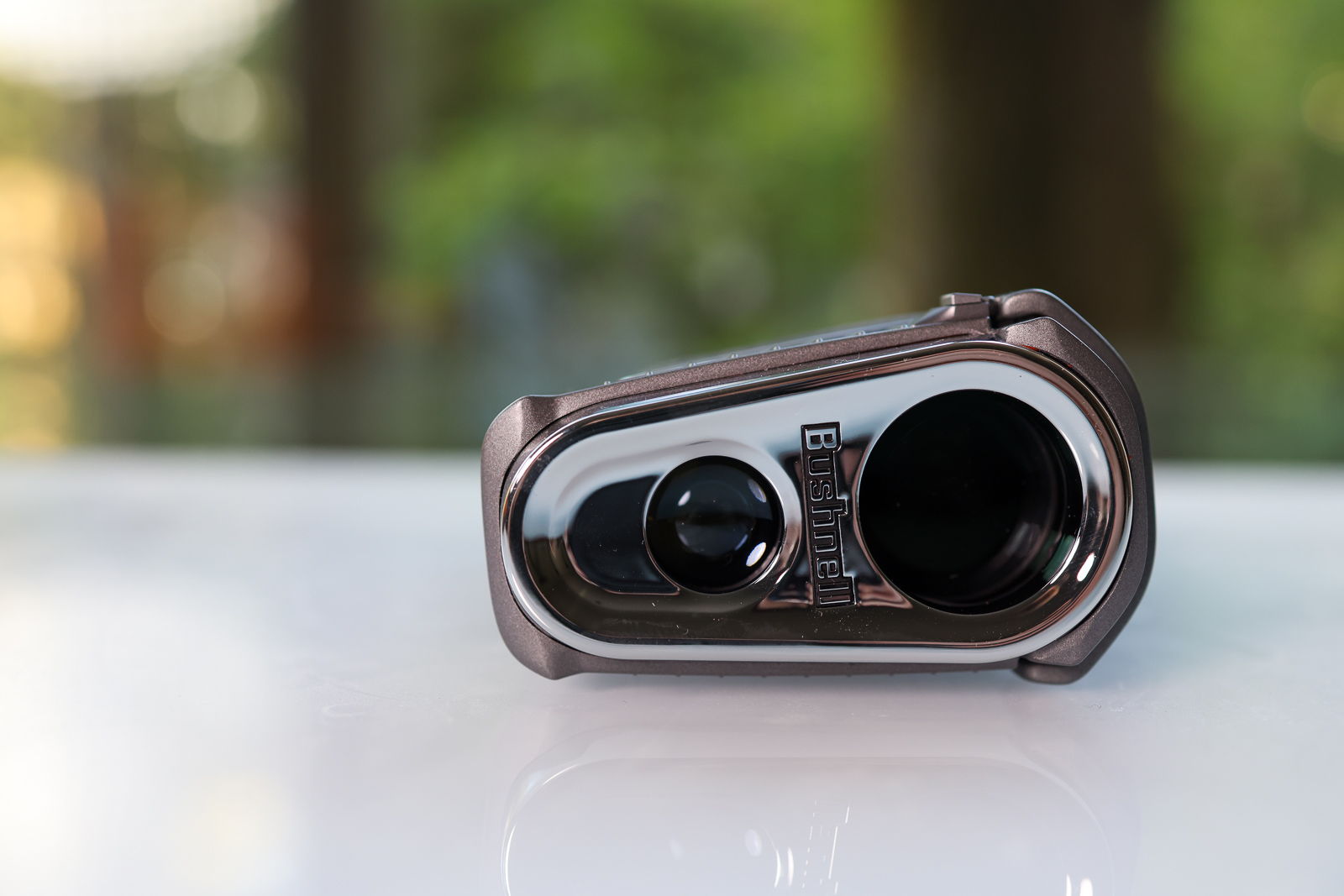Updated in April 2023 to include references and commentary on the new Bushnell Tour V6 Shift.
For years, the Bushnell
Yes, it was (and is) expensive. But it undoubtedly had the best combination of build quality, accuracy, and features.
But in 2022, this started changing. (See our list of the best rangefinders in golf, to see what I mean.)
All of the competitors? They started catching up.
The
Bushnell followed it up with the release of the excellent mid-tier model the Tour V5 in January 2020.
But since then? Radio silent.
And unfortunately for them, in the last two years, the competition has gotten very good.
The Precision Pro NX10 is every bit as good as the V5, for less money.
The Cobalt Q6 Slope compares very well to the
And in the budget $200-ish dollar range there are now plenty of worthy devices that are making more consumers say “do I really need to pay $600 for a rangefinder?”
Fast forward to October 2022, and Bushnell has finally released their answer to all of those new devices: the Bushnell Pro X3.
This is their signature rangefinder, and my expectations for it are sky-high.
But does it live up to them? Does it allow Bushnell to definitively reclaim its title as “King of the Rangefinders?”
I’ve now used and tested the Pro X3 extensively, and we’re going to answer that question in this review.
Take our 30 second quiz and I'll recommend the perfect golf rangefinder based on your budget, goals, and preferences.
Update July 2024: There are New Bushnell Rangefinders in Town
If you’re considering purchasing the Pro X3, you may want to also take a look at the Tour V6 Shift.
It’s not quite as big, and it doesn’t have some of the most high-tech features of the Pro X3. But the build quality is great, and its “Jolt” feature is the best we’ve tested in any Bushnell rangefinder to date.
So if you want a high-quality device from a name brand, and want to save $200 in the process? Check out our Tour V6 Shift review to get more details.
Also, Bushnell has released the new Bushnell Pro X3+ as well. It’s essentially the same as the Pro X3 in this review, but it adds real time wind data. Here’s our full plus review.
Ok, back to our Pro X3 review!
First Impressions of the Bushnell Pro X3
Out of the box, the Bushnell Pro X3 has a similar look to its predecessor the
The Bushnell X line has always had a presence. They’re among the biggest and heaviest rangefinders on the market, and the X3 is no different.
It’s similar in size and weight to the XE, but even slightly wider at the top of the device due to the new slope toggle switch.
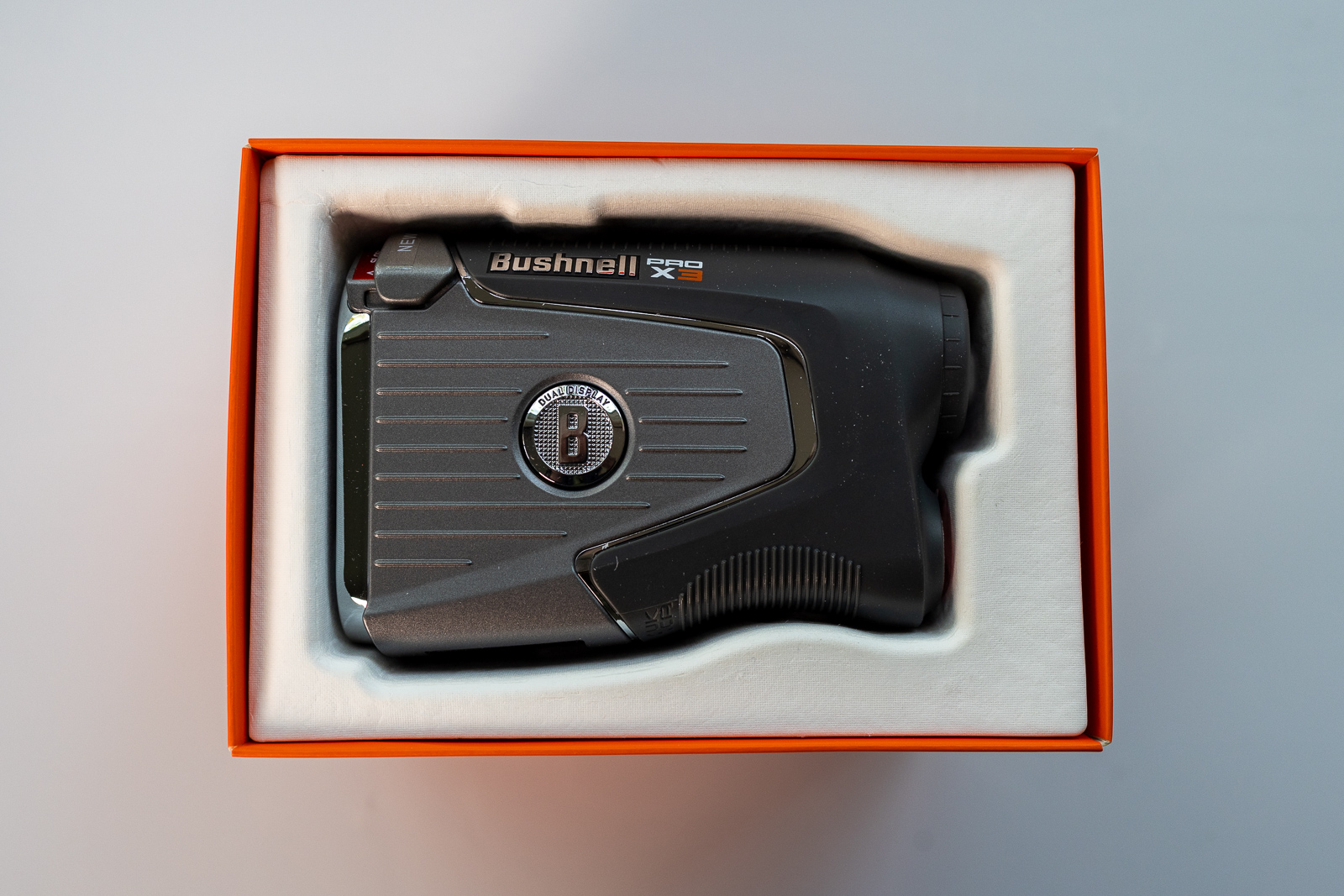
From a design standpoint, that’s one of just a couple minor differences between the X3 and the outgoing model.
The slope switch now slides in and out near the lens of the rangefinder. The Bushnell logo on the side, which used to toggle slope, now switches from standard black, to the illuminated red display within the device.
There’s also a slight difference to the focus ring as well.
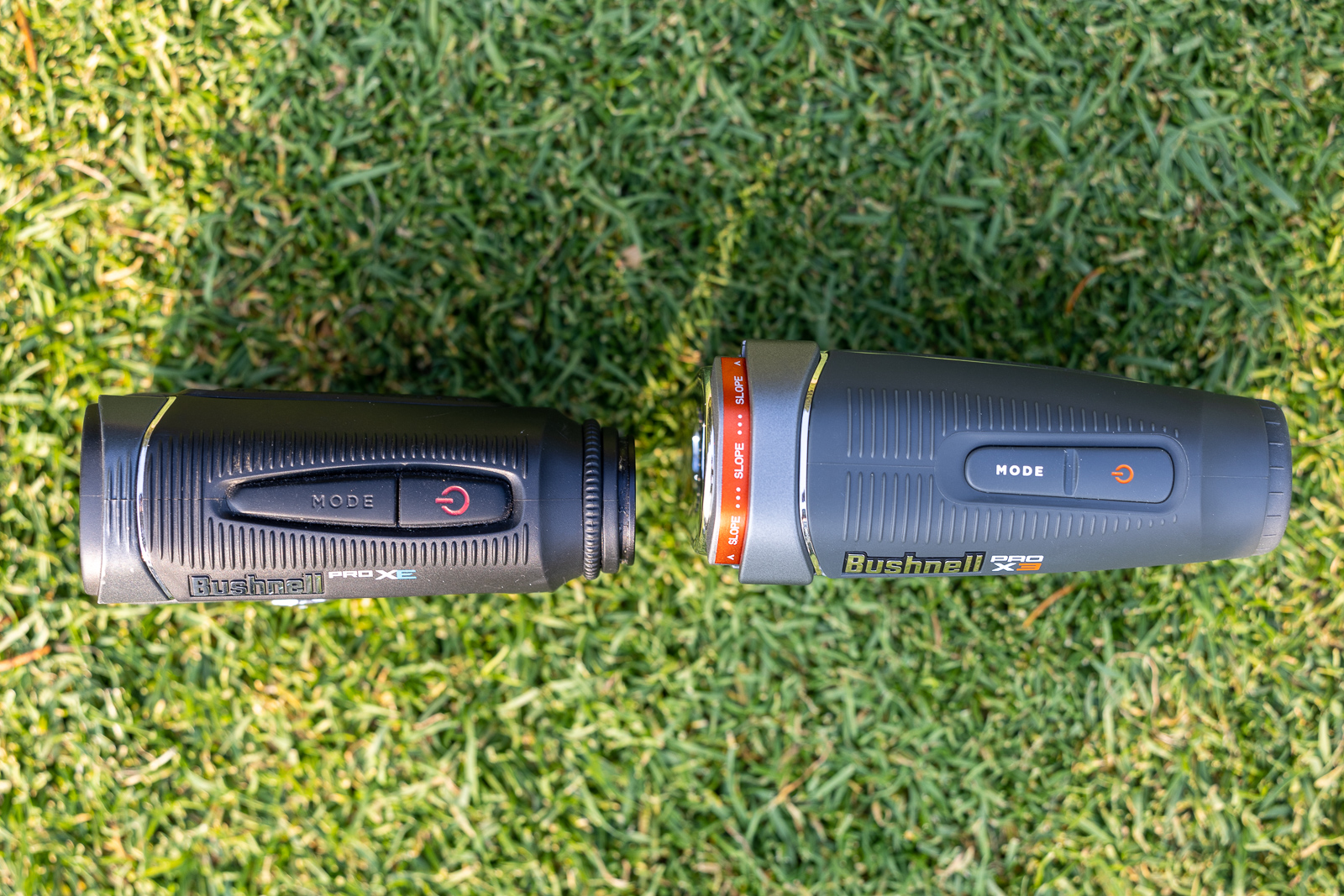
Otherwise, aside from some updated styling, the X3 looks and feels very similar to the XE – and this is a good thing.
I personally prefer a substantial rangefinder. Having it bigger and with a little weight behind it gives you a sense of confidence when you use it.
It’s less shaky and easier to range the target, and it screams of better build quality, which is where many of the rangefinder startups are still lagging a bit behind.
Overall, the Bushnell Pro X3 is a great-looking device, despite being pretty similar to the previous model.
But the question is, does it work as well as advertised and is it worth the upgrade from an older model?
Bushnell Pro X3 in the Box
In the box, you’re not going to find any surprises.
Upon opening it up, you’ll find the device itself, and underneath a brief quickstart guide, microfiber cloth for cleaning, and a Bushnell carrying case.
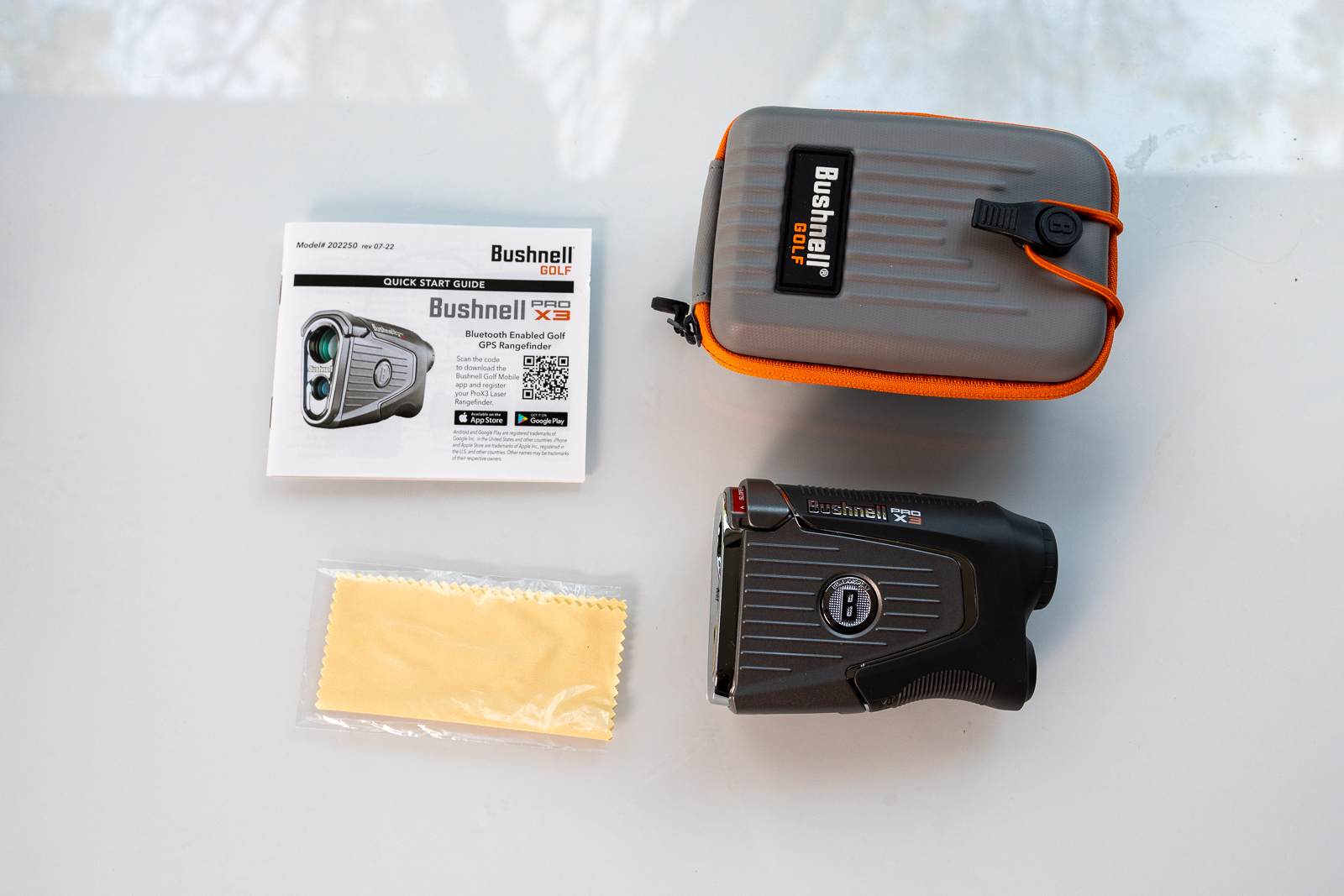
The case is the same case that ships with the Tour V5.
It’s sturdy, feels waterproof, and does the job well.
This is an area where I’m kind of surprised we didn’t see Bushnell try and do something a little bit different.
The case isn’t generally a big deal – it’s an afterthought for most brands. But in a world of increasing competition, to have found a little way to upgrade and do something unique feels like a missed opportunity. Especially considering this is the same case that comes with the V5 which costs half as much.
At the same time, I suppose there’s always the mindset of “if it ain’t broke, don’t fix it.”
Not sure you want to spend $600 on the Pro X3? See how it compares to recently released $400 Tour V6 Shift:
Bushnell Pro X3 Features
Bushnell is advertising the Pro X3 as the most feature-heavy rangefinder on the market.
Is that true? Eh, maybe, maybe not.
It certainly has some unique features, but so do a lot of other devices.
GPS rangefinders like the Precision Pro R1 and Garmin Z82, cram a ton of tech into their devices – but they also serve a bit of a different market.
The Smart Switch on the Cobalt Q6 allows you to easily adjust the brightness of the backlit display, which the Pro X3 can’t do.
Bushnell Pro X3 Slope with Elements
But what the Bushnell Pro X3 can do, that no other standard rangefinder does?
It incorporates “elements” into its slope calculations.
This was first introduced with the
The Pro X3 takes things a step further with an altitude sensor as well.
You’re able to enter the altitude of your home course, and then it will use the sensor to adjust from there to take elevation into account while playing.
The idea is it will give you the most accurate slope calculation possible.
The X3 does this seamlessly, and the numbers are as good, or better, than any rangefinder I’ve found.
With one big caveat.
Wind.
The X3 can give you all the details about temperature, elevation, slope – but if there’s a 15 mph wind in your face? Then the number, as with most slope numbers, is no longer as useful.
This is one area where other advances in the industry have caught up.
The R1 and Z82 which has GPS built in, do have wind data.
Arccos Caddie factors wind data into its recommendations.
So while what the Pro x3 does is very impressive for a traditional rangefinder, there are other golf tools, that can help give extra data that the X3 can’t.
But obviously, there are pros and cons to everything.
Those other devices have more data, but also rely on USB charging, pairing to an app, and can be more intrusive to your golf game.
Is the Bushnell Pro X3 a GPS Rangefinder?
One bit of confusion with the Pro X3 is that it markets itself as a “GPS Rangefinder”.
This would leave you to believe it functions similarly to the R1 and Z82 I mentioned, where it will give you GPS yardages within the device.
This isn’t the case.
The Bushnell Pro X3 can pair with the Bushnell app, which then has GPS data regarding the course you’re playing while allowing you to keep score and get additional data within the app.
But when it comes to integrating the rangefinder itself with the app, currently all it does is make it easier to adjust settings within the device.
This was pretty disappointing, to be honest.
There’s just not a lot of value here, and I feel like the marketing of the GPS feature is a bit misleading.
Even the newer Bushnell Pro X3+ which has real-time wind data, doesn’t provide any GPS info – despite directly connecting to the GPS app.
That said, the Bushnell app is very good. And if you’re using a device like the Wingman Speaker or the new iOn Elite Watch (our review forthcoming), it’s a great tool to have on the course.
But, there are a lot of great GPS apps out there, so it’s not like this is an overly unique feature.
Bushnell Bite Magnet
If I remember correctly, the
Now, this has practically become the industry standard for most rangefinders, and the implementation of it in the X3 works as well as expected.
The magnet is very strong, and I have zero concerns about it flying off a cart.
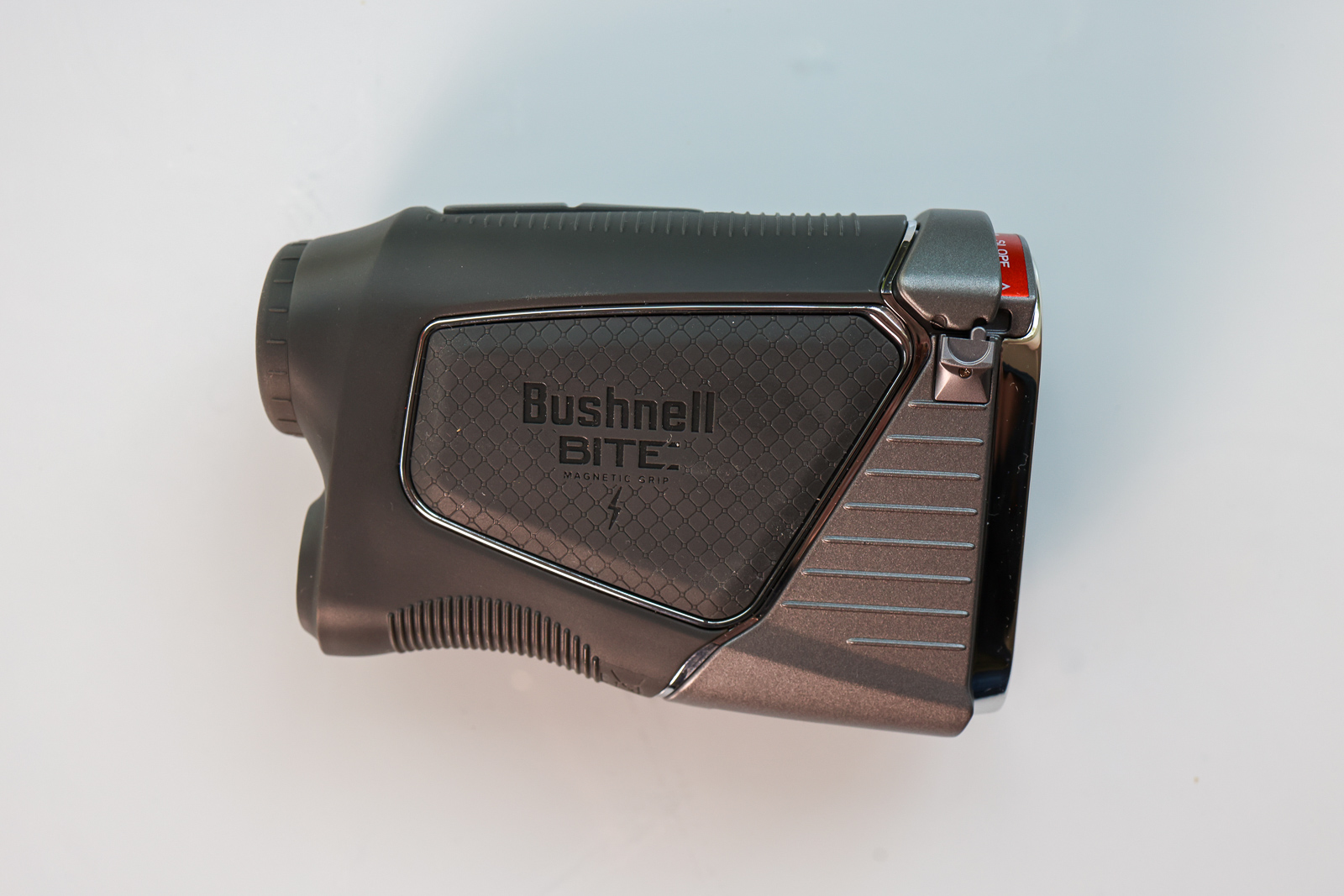
Slope and Display Switches
As I mentioned above, Bushnell opted for a new Slope toggle this go around.
Honestly? I personally prefer the way it was executed on the Pro XE where the logo on the side of the device just slides.
The new way locks into place, so if you play in a lot of tournaments and want to make sure you don’t inadvertently turn on the slope during an event, then this will be great for you.
The logo still has a function however in that you can toggle between a standard black display and an illuminated red display.
It works great and is certainly easier than using menu buttons as was the case in the past.
A minor change and most people will just leave it on, and not have to worry about it much.
The Bushnell Pro X3 improves upon it's flagship Pro XE in subtle, but meaningful ways. If you want the best of the best, the X3 is the rangefinder for you.
Bushnell Pro X3 Build Quality and Waterproof Rating
The Bushnell really sets itself apart from the competition when it comes to it’s build quality.
The Pro X3 is built like a tank, and is hands down the best on the market from this standpoint.
But the Cobalt Q6 comes close, but the X3 takes the nod here.
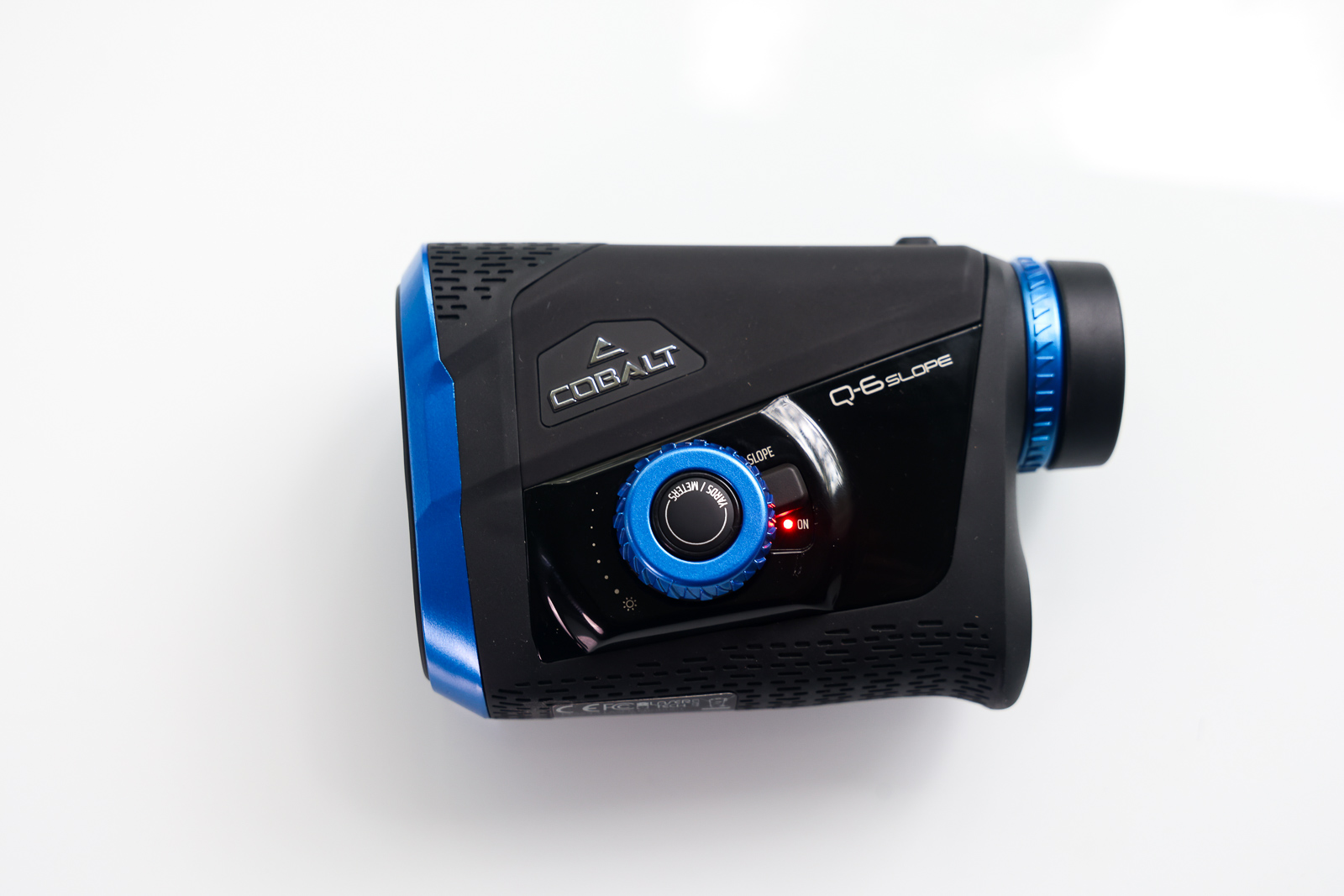
The Bushnell Pro X3 also has an IPX7 waterproof rating, which is the highest I’ve seen in a golf rangefinder (the Cobalt also has IPX7)
This means it can withstand full immersion in up to 3 feet of water for 30 minutes. Let’s hope this never becomes an issue for you, but it’s nice to know if your clubs roll into a lake, your rangefinder will likely be just fine (hey, I’ve seen it happen!).
Many other cheaper devices are usually IP54, which will protect it from dust and water splashes, but isn’t fully “waterproof.”
How Does the Bushnell Pro X3 Perform
Ok, I know parts of this review may have come across a little harsh. But that’s only because the Pro X3 has such lofty expectations to live up to – and the rangefinder market as a whole has expanded significantly over the last few years.
Whether it’s GPS watches, swing sensors, apps – there are lots of ways to get your data now.
And when you have a brand like Garmin who can leverage all of those things within one system? It’s important to weigh all the options before dropping significant money on a device.
Now, having said that, how does the Pro X3 perform?
Wonderfully.
As a straight rangefinder, the Pro X3 is the best I’ve ever used.
The form factor and weight feel great.
Comparing the optics side by side to the
The glass is slightly clearer, and the illuminated display is brighter.
The yardages are displayed in slightly bigger text too, which helps legibility – but it still maintains a minimalist take, and doesn’t give you extra data you don’t need like many cheaper rangefinders.
My biggest complaint with my (this may be unique to my device)
I’m happy to report this absolutely isn’t the case with the Pro X3. The Jolt feature works perfectly when it locks onto a flag, and it has the added benefit of “Visual Jolt” where the outer ring of the display lights up in red as well when it locks on.
Unlike the Precision Pro NX10 which will vibrate pretty much anytime you get any distance, the Jolt in the X3 does what it should, and only vibrates when it locks onto a flag.
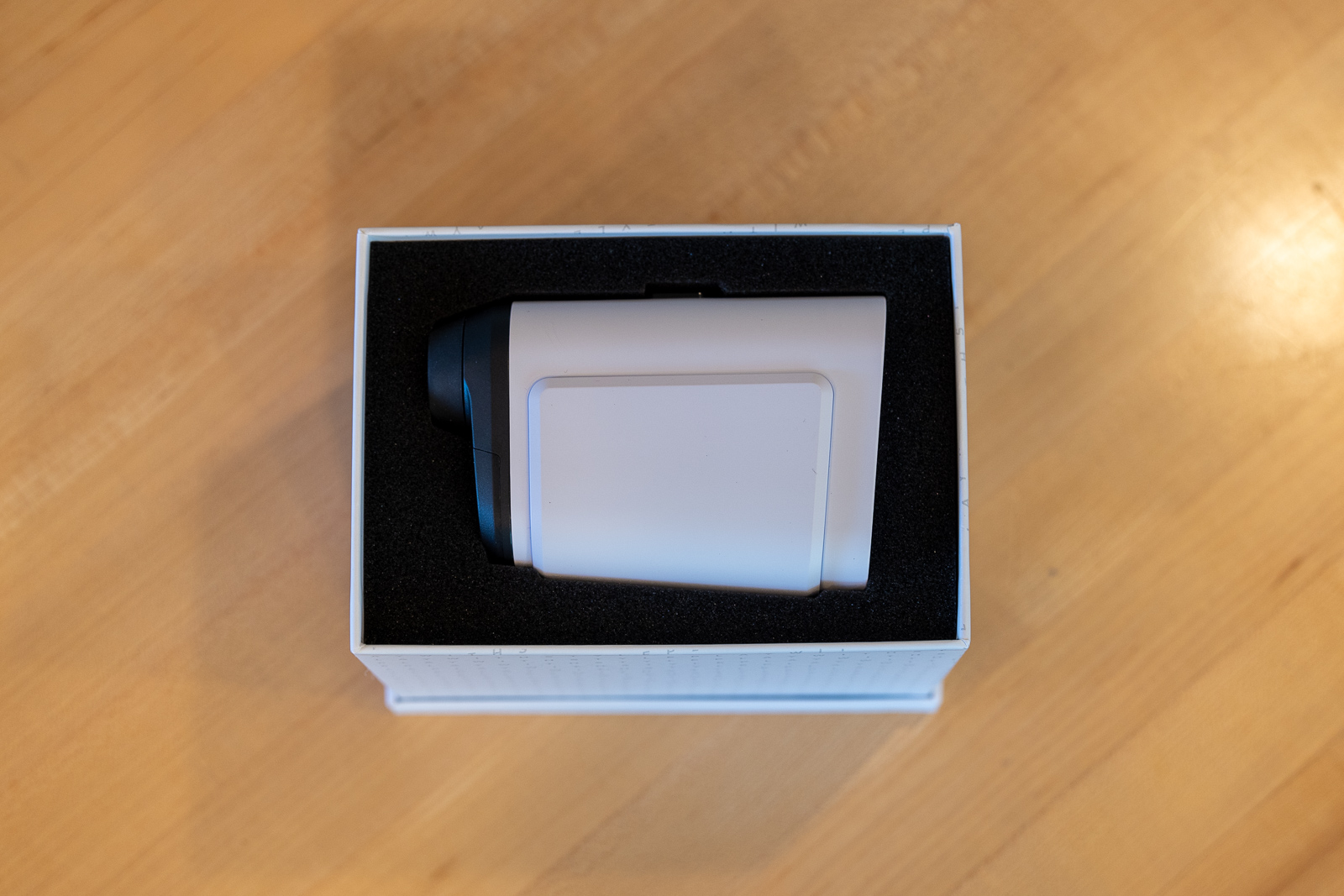
This along with the Cobalt Q6 have the best implementation of this feature on the market.
One change I’ve noticed with the X3 from the XE is that you can hold down the “Fire” button and slowly move it around the scene to get different distances.
I’ve found “Scan” features in other rangefinders to often not work very well, and the numbers tend to bounce all over the place.
This isn’t the case with the Pro X3. You can slowly move from a tree behind a green, to the pin, to say a bunker lip, and it takes a second and then gives you the yardage, without bouncing all over the place.
It’s implemented well, and is genuinely useful.
The X3 is also very fast, but most new devices these days are.
Final Thoughts on the Bushnell Pro X3
If you’re looking for the tl;dr, here it is:
The Bushnell Pro X3 is the best rangefinder I’ve ever used.
But.
When the
Now it’s not nearly as cut and dry.
There are a lot of options out there, and the Pro X3 is probably not the best for everybody.
For around $259 with our coupon code you can get the Precision Pro NX10 which will give you fast, accurate distances in a device that’s enjoyable to use. It’s also less than half the cost of the X3.
You can get the Cobalt Q6 Slope for $450, which is just as fast, just as accurate, and just as confidence-inducing as the Bushnell. You don’t get the Elements Slope adjustments, and more importantly, the Q6 doesn’t have a built-in magnet. But it’s also $150 less for a product that is just about as good in all the areas that matter.
The Bushnell Pro X3 is the best rangefinder Bushnell has ever made. But it’s only marginally better than the still excellent
And while it’s the best rangefinder we’ve tested, at a certain point you have to ask yourself if it’s worth spending the extra money, when you can get something close to as good for much less.
That said, if you want the best of the best, and you want a device that is going to last you for many years to come, then buy the Pro X3 and don’t look back. You’ll be extremely happy with it.
I played nearly every round of golf from the Spring of 2019 to late 2021 with the
If you’re looking for more detailed comparisons between models, check out our overview of the best Bushnell Golf rangefinders.
The Bushnell Pro X3 improves upon it's flagship Pro XE in subtle, but meaningful ways. If you want the best of the best, the X3 is the rangefinder for you.
This page contains affiliate links. This means that if you click a link and buy one of the products on this page, I may receive a commission (at no extra cost to you!) This doesn’t affect our opinions or our reviews. Everything we do is to benefit you as the reader, so all of our reviews are as honest and unbiased as possible.
It's expensive, but this is the best overall rangefinder in golf
The Bushnell Pro X3 is expensive and it's high tech "slope with elements" doesn't feel extremely useful. But when you combine accuracy, build quality, speed, and features - this is the best rangefinder in golf. But at $599 it's expensive, and many people will be just as well served by devices costing $150-200 less like the Bushnell Tour V6, Cobalt Q-6, or Voice Caddie TL1.
The Good
- Top of the line build quality
- Extremely fast and accurate rangefinding and Jolt features
- Looks great
The Bad
- Will be too big and heavy for some people
- Expensive
-
Presentation
-
Performance
-
Price
-
Personal Affinity

